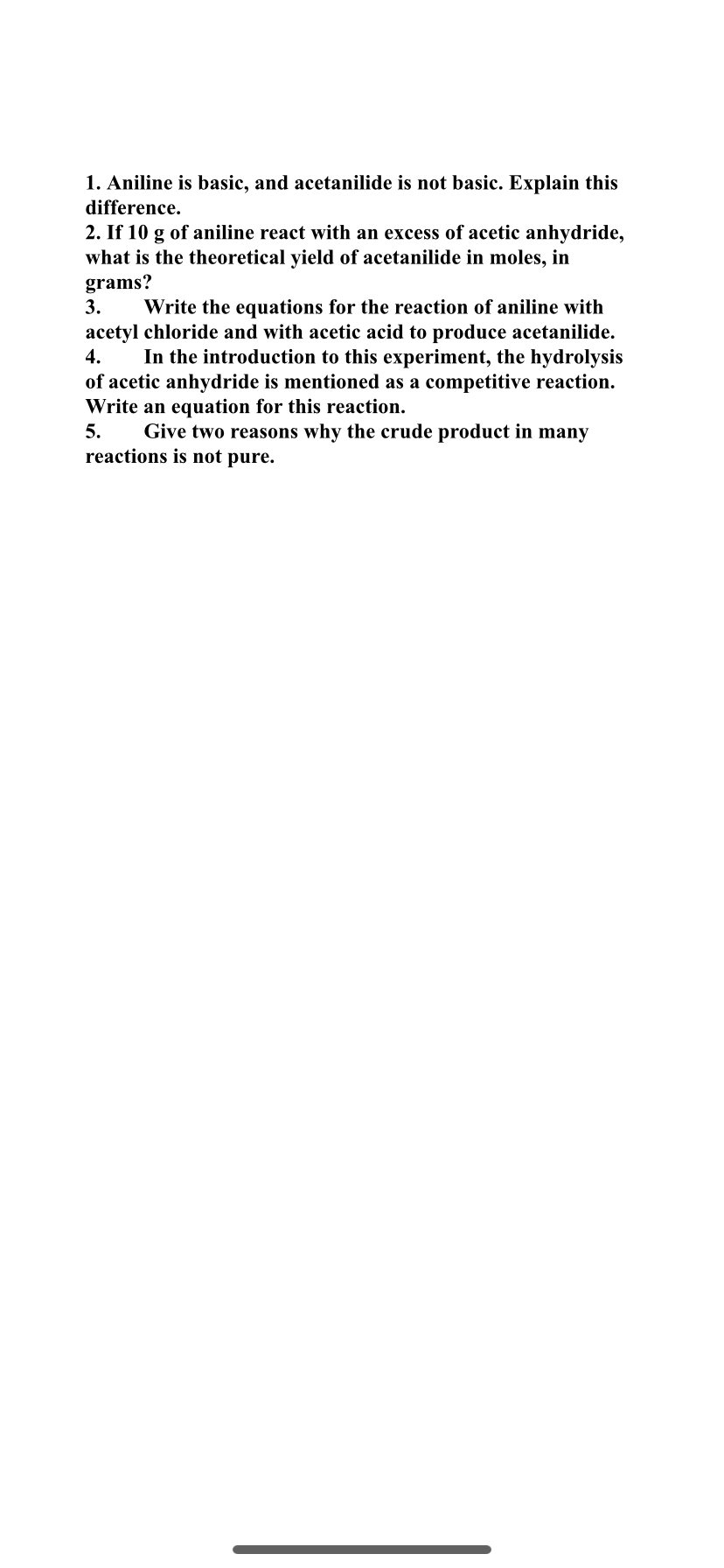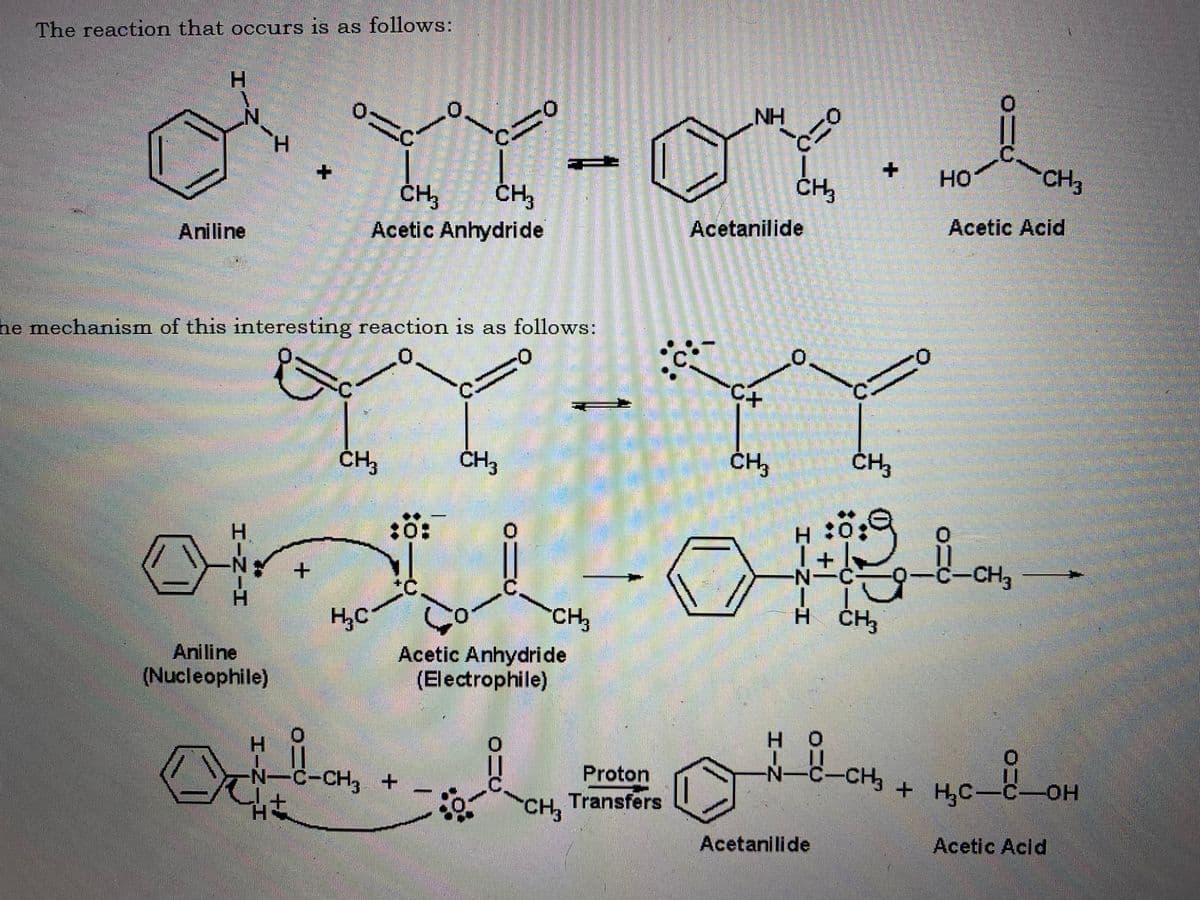1. Aniline is basic, and acetanilide is not basic. Explain this difference. 2. If 10 g of aniline react with an excess of acetic anhydride, what is the theoretical yield of acetanilide in moles, in grams? 3. Write the equations for the reaction of aniline with acetyl chloride and with acetic acid to produce acetanilide. In the introduction to this experiment, the hydrolysis of acetic anhydride is mentioned as a competitive reaction. 4. Write an equation for this reaction. 5. Give two reasons why the crude product in many reactions is not pure.
1. Aniline is basic, and acetanilide is not basic. Explain this difference. 2. If 10 g of aniline react with an excess of acetic anhydride, what is the theoretical yield of acetanilide in moles, in grams? 3. Write the equations for the reaction of aniline with acetyl chloride and with acetic acid to produce acetanilide. In the introduction to this experiment, the hydrolysis of acetic anhydride is mentioned as a competitive reaction. 4. Write an equation for this reaction. 5. Give two reasons why the crude product in many reactions is not pure.
Organic Chemistry: A Guided Inquiry
2nd Edition
ISBN:9780618974122
Author:Andrei Straumanis
Publisher:Andrei Straumanis
Chapter19: Eas: Electrophilic Aromatic Substitution
Section: Chapter Questions
Problem 4E
Related questions
Question
help with the questions except number 1

Transcribed Image Text:1. Aniline is basic, and acetanilide is not basic. Explain this
difference.
2. If 10 g of aniline react with an excess of acetic anhydride,
what is the theoretical yield of acetanilide in moles, in
grams?
3.
Write the equations for the reaction of aniline with
acetyl chloride and with acetic acid to produce acetanilide.
In the introduction to this experiment, the hydrolysis
of acetic anhydride is mentioned as a competitive reaction.
4.
Write an equation for this reaction.
5.
Give two reasons why the crude product in many
reactions is not pure.

Transcribed Image Text:The reaction that occurs is as follows:
H.
NH
H.
но
CH3
ČH,
Acetic Acid
Acetanilide
Aniline
Acetic Anhydride
he mechanism of this interesting reaction is as follows:
to
ČH3
CH3
ČH,
:o:
+
C-CH3
CH3
H CH3
H,C
Acetic Anhydride
(Electrophile)
Aniline
(Nucleophile)
HO
H
Proton
N-C-CH,
+
H,C-
c-OH
HO-
N-C-CH3 +
Transfers
CH3
Acetanilide
Acetic Acid
HINIH
Expert Solution
This question has been solved!
Explore an expertly crafted, step-by-step solution for a thorough understanding of key concepts.
Step by step
Solved in 3 steps with 1 images

Knowledge Booster
Learn more about
Need a deep-dive on the concept behind this application? Look no further. Learn more about this topic, chemistry and related others by exploring similar questions and additional content below.Recommended textbooks for you

Organic Chemistry: A Guided Inquiry
Chemistry
ISBN:
9780618974122
Author:
Andrei Straumanis
Publisher:
Cengage Learning


Organic Chemistry
Chemistry
ISBN:
9781305580350
Author:
William H. Brown, Brent L. Iverson, Eric Anslyn, Christopher S. Foote
Publisher:
Cengage Learning

Organic Chemistry: A Guided Inquiry
Chemistry
ISBN:
9780618974122
Author:
Andrei Straumanis
Publisher:
Cengage Learning


Organic Chemistry
Chemistry
ISBN:
9781305580350
Author:
William H. Brown, Brent L. Iverson, Eric Anslyn, Christopher S. Foote
Publisher:
Cengage Learning